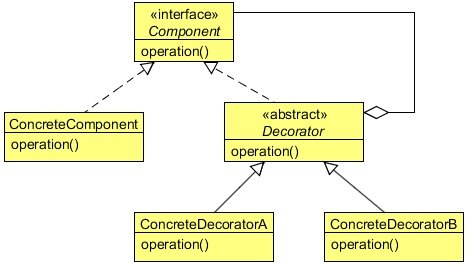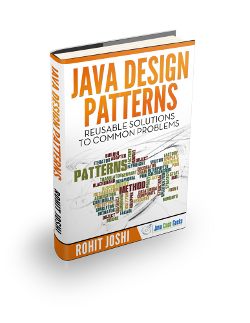Decorator Design Pattern Example
This article is part of our Academy Course titled Java Design Patterns.
In this course you will delve into a vast number of Design Patterns and see how those are implemented and utilized in Java. You will understand the reasons why patterns are so important and learn when and how to apply each one of them. Check it out here!
Table Of Contents
1. Introduction
To understand the Decorator Design Pattern, let’s help a pizza company make an extra topping calculator. A user can ask to add extra topping to a pizza and our job is to add toppings and increase its price using the system.
This is something like adding an extra responsibility to our pizza object at runtime and the Decorator Design Pattern is suitable for this type of requirement. But before that, let us know more about this beautiful pattern.
2. What is the Decorator Design Pattern
The intent of the Decorator Design Pattern is to attach additional responsibilities to an object dynamically. Decorators provide a flexible alternative to sub-classing for extending functionality.
The Decorator Pattern is used to extend the functionality of an object dynamically without having to change the original class source or using inheritance. This is accomplished by creating an object wrapper referred to as a Decorator around the actual object.
The Decorator object is designed to have the same interface as the underlying object. This allows a client object to interact with the Decorator object in exactly the same manner as it would with the underlying actual object. The Decorator object contains a reference to the actual object. The Decorator object receives all requests (calls) from a client. In turn, it forwards these calls to the underlying object. The Decorator object adds some additional functionality before or after forwarding requests to the underlying object. This ensures that the additional functionality can be added to a given object externally at runtime without modifying its structure.
Decorator prevents the proliferation of subclasses leading to less complexity and confusion. It is easy to add any combination of capabilities. The same capability can even be added twice. It becomes possible to have different decorator objects for a given object simultaneously. A client can choose what capabilities it wants by sending messages to an appropriate decorator.
Component
- Defines the interface for objects that can have responsibilities added to them dynamically.
ConcreteComponent
- Defines an object to which additional responsibilities can be attached.
Decorator
- Maintains a reference to a
Componentobject and defines an interface that conforms to Component’s interface.
ConcreteDecorator
- Adds responsibilities to the component.
3. Implementing the Decorator Design Pattern
For simplicity, let’s create a simple Pizza interface which contains only two methods.
package com.javacodegeeks.patterns.decoratorpattern;
public interface Pizza {
public String getDesc();
public double getPrice();
}
The getDesc method is used to get the pizza’s description whereas the getPrice is used to get the price.
Below are the two concrete Pizza classes:
package com.javacodegeeks.patterns.decoratorpattern;
public class SimplyVegPizza implements Pizza{
@Override
public String getDesc() {
return "SimplyVegPizza (230)";
}
@Override
public double getPrice() {
return 230;
}
}
package com.javacodegeeks.patterns.decoratorpattern;
public class SimplyNonVegPizza implements Pizza{
@Override
public String getDesc() {
return "SimplyNonVegPizza (350)";
}
@Override
public double getPrice() {
return 350;
}
}
The decorator wraps the object which functionality needs to be increased, so it needs to implement the same interface. Below is an abstract decorator class which will be extended by all the concrete decorators.
package com.javacodegeeks.patterns.decoratorpattern;
public abstract class PizzaDecorator implements Pizza {
@Override
public String getDesc() {
return "Toppings";
}
}
The following are the concrete decorator classes.
package com.javacodegeeks.patterns.decoratorpattern;
public class Broccoli extends PizzaDecorator{
private final Pizza pizza;
public Broccoli(Pizza pizza){
this.pizza = pizza;
}
@Override
public String getDesc() {
return pizza.getDesc()+", Broccoli (9.25)";
}
@Override
public double getPrice() {
return pizza.getPrice()+9.25;
}
}
package com.javacodegeeks.patterns.decoratorpattern;
public class Cheese extends PizzaDecorator{
private final Pizza pizza;
public Cheese(Pizza pizza){
this.pizza = pizza;
}
@Override
public String getDesc() {
return pizza.getDesc()+", Cheese (20.72)";
}
@Override
public double getPrice() {
return pizza.getPrice()+20.72;
}
}
package com.javacodegeeks.patterns.decoratorpattern;
public class Chicken extends PizzaDecorator{
private final Pizza pizza;
public Chicken(Pizza pizza){
this.pizza = pizza;
}
@Override
public String getDesc() {
return pizza.getDesc()+", Chicken (12.75)";
}
@Override
public double getPrice() {
return pizza.getPrice()+12.75;
}
}
package com.javacodegeeks.patterns.decoratorpattern;
public class FetaCheese extends PizzaDecorator{
private final Pizza pizza;
public FetaCheese(Pizza pizza){
this.pizza = pizza;
}
@Override
public String getDesc() {
return pizza.getDesc()+", Feta Cheese (25.88)";
}
@Override
public double getPrice() {
return pizza.getPrice()+25.88;
}
}
package com.javacodegeeks.patterns.decoratorpattern;
public class GreenOlives extends PizzaDecorator{
private final Pizza pizza;
public GreenOlives(Pizza pizza){
this.pizza = pizza;
}
@Override
public String getDesc() {
return pizza.getDesc()+", Green Olives (5.47)";
}
@Override
public double getPrice() {
return pizza.getPrice()+5.47;
}
}
package com.javacodegeeks.patterns.decoratorpattern;
public class Ham extends PizzaDecorator{
private final Pizza pizza;
public Ham(Pizza pizza){
this.pizza = pizza;
}
@Override
public String getDesc() {
return pizza.getDesc()+", Ham (18.12)";
}
@Override
public double getPrice() {
return pizza.getPrice()+18.12;
}
}
package com.javacodegeeks.patterns.decoratorpattern;
public class Meat extends PizzaDecorator{
private final Pizza pizza;
public Meat(Pizza pizza){
this.pizza = pizza;
}
@Override
public String getDesc() {
return pizza.getDesc()+", Meat (14.25)";
}
@Override
public double getPrice() {
return pizza.getPrice()+14.25;
}
}
package com.javacodegeeks.patterns.decoratorpattern;
public class RedOnions extends PizzaDecorator{
private final Pizza pizza;
public RedOnions(Pizza pizza){
this.pizza = pizza;
}
@Override
public String getDesc() {
return pizza.getDesc()+", Red Onions (3.75)";
}
@Override
public double getPrice() {
return pizza.getPrice()+3.75;
}
}
package com.javacodegeeks.patterns.decoratorpattern;
public class RomaTomatoes extends PizzaDecorator{
private final Pizza pizza;
public RomaTomatoes(Pizza pizza){
this.pizza = pizza;
}
@Override
public String getDesc() {
return pizza.getDesc()+", Roma Tomatoes (5.20)";
}
@Override
public double getPrice() {
return pizza.getPrice()+5.20;
}
}
package com.javacodegeeks.patterns.decoratorpattern;
public class Spinach extends PizzaDecorator{
private final Pizza pizza;
public Spinach(Pizza pizza){
this.pizza = pizza;
}
@Override
public String getDesc() {
return pizza.getDesc()+", Spinach (7.92)";
}
@Override
public double getPrice() {
return pizza.getPrice()+7.92;
}
}
We need to decorate our pizza object with these toppings. The above classes contain a reference to a pizza object that needs to be decorated. The decorator object adds its functionality to the decorator after calling the decorator’s function.
package com.javacodegeeks.patterns.decoratorpattern;
import java.text.DecimalFormat;
public class TestDecoratorPattern {
public static void main(String[] args) {
DecimalFormat dformat = new DecimalFormat("#.##");
Pizza pizza = new SimplyVegPizza();
pizza = new RomaTomatoes(pizza);
pizza = new GreenOlives(pizza);
pizza = new Spinach(pizza);
System.out.println("Desc: "+pizza.getDesc());
System.out.println("Price: "+dformat.format(pizza.getPrice()));
pizza = new SimplyNonVegPizza();
pizza = new Meat(pizza);
pizza = new Cheese(pizza);
pizza = new Cheese(pizza);
pizza = new Ham(pizza);
System.out.println("Desc: "+pizza.getDesc());
System.out.println("Price: "+dformat.format(pizza.getPrice()));
}
}
The above code will results the following output:
Desc: SimplyVegPizza (230), Roma Tomatoes (5.20), Green Olives (5.47), Spinach (7.92) Price: 248.59 Desc: SimplyNonVegPizza (350), Meat (14.25), Cheese (20.72), Cheese (20.72), Ham (18.12) Price: 423.81
In the above class, first we have created a SimplyVegPizza and then decorated it with RomaTomatoes, GreenOlives, and Spinach. The desc in the output shows the toppings added in the SimplyVegPizza and the price are the sum of all.
We did the same thing for the SimplyNonVegPizza and added different topping on it. Please note that you can decorate the same thing more than once for an object. In the above example, we added cheese twice; it got added twice in the price too, which can be seen in the output.
The Decorator Design Pattern looks good when you need to add extra functionality to an object with modifying it, at runtime. But this results in lots of little objects. A design that uses Decorator often results in systems composed of lots of little objects that all look alike. The objects differ only in the way they are interconnected, not in their class or in the value of their variables. Although these systems are easy to customize by those who understand them, they can be hard to learn and debug.
4. When to use the Decorator Design Pattern
Use the Decorator pattern in the following cases:
- To add responsibilities to individual objects dynamically and transparently, that is, without affecting other objects.
- For responsibilities that can be withdrawn.
- When extension by sub-classing is impractical. Sometimes a large number of independent extensions are possible and would produce an explosion of subclasses to support every combination. Or a class definition may be hidden or otherwise unavailable for sub-classing.
5. Decorator Design Pattern in Java
java.io.BufferedInputStream(InputStream)java.io.DataInputStream(InputStream)java.io.BufferedOutputStream(OutputStream)java.util.zip.ZipOutputStream(OutputStream)java.util.Collections#checked[List|Map|Set|SortedSet|SortedMap]()
6. Download the Source Code
This was a lesson on the Decorator Design Pattern.
You may download the relevant source code here: DecoratorPattern-Project




